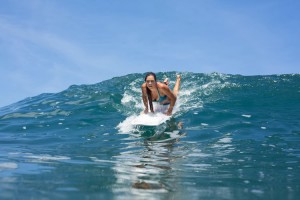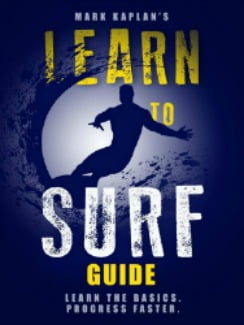Learning to surf real waves is a progression after mastering foam waves. Foam wave techniques are easily applied to real waves. What changes most is the timing and the fear level.
Surf beginners should start with high volume soft top boards on foam waves. They learn to select a good wave, time the wave, catch it, pop up, and ride it to the beach.
To surf real waves the timing changes. A foam wave can be seen from a distance and doesn’t change character. A real wave forms an arc for a few seconds and the surfer has to be positioned in the right spot.

Timing to Surf Real Waves
On a reef beach, the waves break in the same spot each time as they hit the obstacle know as a reef. On a sand bar beach where the sand drifts around the clock, the waves form in different spots and with different looks.
Some days are great real wave days on sand bar beaches and some are not. The look of the waves changes throughout the day with the tides. It is good to recognize when going into the water whether it is a good day or not.
On the Oceanside beach, waves often are steep and close out or wall off giving surfers a very difficult time. Observation of surfers and how long they ride and in which direction indicates the character of the waves. If everyone is dropping down the face and pearling or getting closed out immediately, it is a tough day.
When surfers are all getting up and getting long rides, it is probably a good day. Waves often break first on the outside and those are the bigger waves. A beginner wants a wave that reforms after that and is smaller. The surfer observes where these waves are breaking and goes to that spot.
A beginner can stand and wait for the real wave and just jump on the board when he sees it. Or he can paddle parallel to the waves in the right spot and already be moving when the wave starts to form.
The advantage of moving is that if there is a corner or shoulder breaking right or left, the surfer can catch this forming pocket for a slower and less steep entrance to the wave. The surfer aims at a 45 degree angle towards the beach to stay in front of the pocket.
To ride the face of a real wave, the surfer has to be in front and moving before the wave hits its peak arc. The surfer wants to get pushed by the forward momentum and on his board when the arc peaks over his head.
Practice improves performance and expect a lot of crashes.
Learn More
My New Surfing Course in an E-Book plus Demo Video or Audio Version
Get the 18 Chapter, 7,500 word Course that can prepare you for a lesson or give you the fundamentals if you are going to try it on your own. 10 years of teaching 350 students a year has given me the insights on the most precise measures you must follow for success. This course is what I teach on the dry land and in water instruction. The Course includes a 15 minute video on my dry land and in water demonstration. Only $4.95
Buy the E-Book and start learning $2.99. Learn to Surf
Buy the Paperback on Amazon $7.95
Get Learn to Surf Course in 29 minute AUDIO. Great prep for a lesson, reviewing after a lesson, learning on your own, refreshing after not having surfed for a while. See Table of Contents. Only $7.95.

For Oceanside Surf Lessons, see the Home Page
See the Post Search Lessons Teach Fundamentals
See the Post Catching Real Surf Waves
See my Dry Land and in Water Demo video
See my other Surf site for more Posts
I have lowered the price of Courses and Books for the lock down price of $2.99
80 page Learn to Surf Book
![Surf Instructions Beginner to Advanced: Learn to Ride Waves by [Kaplan, Mark]](https://images-na.ssl-images-amazon.com/images/I/51HswFtoBQL.jpg)